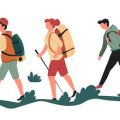Introduction: Why Map Skills Matter
Exploring the vast and beautiful US national forests is a cherished family activity, especially for those new to outdoor adventures. But before you set out on the trails, there’s one essential skill that can make every trip safer, smoother, and more memorable: map navigation. Teaching kids and newcomers how to read maps isn’t just about finding your way from point A to point B—it’s about building confidence, encouraging independence, and fostering a deeper connection with nature.
When families learn map skills together, children gain a sense of accomplishment as they help guide the group or identify landmarks along the route. For newcomers—whether new to hiking, camping, or even to life in the United States—learning to use a map can be an empowering way to participate actively in outings and feel more at home in America’s wild places. Plus, knowing how to navigate with a map helps everyone stay safe by preventing wrong turns and ensuring you’re always aware of your surroundings. Most importantly, these skills encourage us all to slow down, observe our environment, and appreciate the natural beauty that national forests have to offer.
2. Getting Started: Map Basics for All Ages
Introducing map navigation to kids and newcomers in US National Forests can be both exciting and approachable with the right methods. Start by breaking down the essentials into simple, bite-sized lessons that feel more like play than schoolwork. Here’s how you can make your first lessons fun and unintimidating:
Start with the Basics: What Is a Map?
Begin by showing different types of maps—such as trail maps, park maps, and topographic maps. Explain that a map is like a picture of a place from above, helping us understand where things are and how to get there. Use familiar examples, like showing where your family car is parked or where the playground is located.
Map Features Made Simple
| Feature | How to Explain to Kids/Newcomers |
|---|---|
| Legend/Key | This box explains what the symbols mean—like trees for forests or tents for campsites. |
| Scale | The scale tells us how far things really are; use string or fingers to measure distances together. |
| Compass Rose | The compass rose shows which way is north, south, east, and west. Practice pointing these directions out on the map and in real life. |
Introducing the Compass: Making It Hands-On
Show everyone how a compass works. Let kids hold it and watch the needle move. Play games by asking them to point north or find east while standing together. If you’re introducing newcomers, relate it to their everyday experiences—like using GPS on their phones—and show how the compass helps when there’s no cell service in the forest.
Identifying Landmarks: Nature’s Clues
Teach children and beginners to spot landmarks such as large rocks, rivers, unique trees, or mountain peaks. Walk together and let everyone practice matching what they see on the map with what’s around them. For younger kids, turn this into a scavenger hunt—who can find the big oak tree marked on our map first?
Tips for Engaging First Lessons
- Keep explanations short and interactive—let everyone touch and try tools themselves.
- Praise curiosity and questions, turning mistakes into learning opportunities.
- Use stories—share tales of explorers or national park rangers using maps and compasses in real adventures.
- Offer colorful stickers or badges for each new skill learned to keep motivation high.
By starting with easy-to-understand concepts and hands-on activities, families can build confidence together before heading out on longer adventures in America’s beautiful national forests.

3. Fun, Hands-On Activities for the Trail
Exploring a US National Forest is the perfect opportunity to turn map navigation into an adventure for all ages. By incorporating interactive games and engaging scavenger hunts, you can help kids and newcomers gain confidence with maps in a fun, memorable way. Here are some activity ideas you can try on your next forest visit:
Map Relay Race
Divide your family or group into teams and give each team a simple trail map. Mark several checkpoints on the map—like a creek crossing, a giant pine tree, or a scenic overlook. Each team must navigate from point to point using only their maps (no GPS!). For younger kids, keep checkpoints close together and use easy-to-recognize features like picnic areas or trail signs. The first team to complete the course wins a small prize, like choosing the next snack spot!
Scavenger Hunt Adventure
Create a scavenger hunt list based on common features found in national forests such as wildflowers, animal tracks, boulders, or historic cabins. Next to each item on the list, include coordinates or hints about where to find them using the map. Encourage kids to check off each item as they explore, helping them learn to match map symbols with real-world locations. This hands-on approach makes navigation skills feel like part of the game.
Compass Challenge
Introduce older children and adults to basic compass skills by setting up a simple orienteering course. Mark several destinations on your map (for example: “Walk 100 feet north to the footbridge,” or “Head east until you reach the big meadow”). Provide compasses and see who can follow directions accurately. This activity builds confidence in both reading maps and using basic navigation tools.
Family-Friendly Tips
- Always review safety rules before starting any game.
- Let everyone take turns leading—kids love feeling responsible!
- Use waterproof map cases or zip-top bags to protect your maps from dirt and rain.
Keep It Playful and Inclusive
The best learning happens when everyone is having fun. Adapt activities for different ages—little ones might enjoy matching pictures to map symbols, while teens may love a timed navigation challenge. With these hands-on ideas, families can bond while building important outdoor skills that will last a lifetime.
4. Tech Meets Nature: Helpful Apps and Digital Tools
Exploring the wonders of US National Forests has never been easier or more engaging, thanks to modern technology. Many families and newcomers now combine traditional map navigation skills with user-friendly mobile apps and GPS devices. This blend not only makes outdoor adventures safer but also helps kids and new explorers build confidence as they navigate new trails together.
Family-Friendly Navigation Apps and GPS Tools
There’s a variety of digital tools designed to make your forest adventure more enjoyable and secure. Here’s a quick comparison of popular options:
| App/Tool | Main Features | Why Families Love It |
|---|---|---|
| AllTrails | Trail maps, GPS tracking, reviews, offline access | User-friendly, filter for kid-friendly or easy hikes, community tips |
| Gaia GPS | Topographic maps, route planning, offline navigation | Great for planning ahead and tracking your journey in remote areas |
| Google Maps | Basic trail info, satellite view, directions | Familiar interface, good for beginners and quick searches |
| Geocaching App | Treasure hunting with GPS, clues, community fun | Makes hiking exciting for kids by turning it into an adventure game |
| Garmin Handheld GPS Devices | Durable hardware, long battery life, detailed navigation | Reliable in areas with poor cell service; good backup for safety |
Blending Classic Skills With Modern Tech
While digital tools offer convenience and added security, teaching kids and newcomers how to read paper maps and use a compass is still essential—especially in remote forest areas where phone signals may drop. Encourage your family to check their location on both a paper map and an app. Practice finding landmarks both digitally and visually. This way, everyone learns to trust their instincts while also enjoying the reassurance that technology brings.
Safety First: Empowering Experiences for All Ages
Using tech together can be a wonderful family bonding experience—let younger children take turns checking the app or carrying the GPS device. Discuss “what if” scenarios: What would you do if your phone battery died? How would you find your way back using traditional tools? Blending old-school map reading with new-age gadgets ensures that every family member feels confident, safe, and empowered during your adventures in America’s beautiful national forests.
5. Safety First: Navigating Challenges Together
Exploring US National Forests is a wonderful family adventure, but safety should always come first—especially when teaching kids and newcomers how to navigate with maps. Following park ranger recommendations can help you prepare for unexpected situations and empower your whole group to handle challenges together. Here are some practical safety tips every family should know before heading out:
What to Do If You Get Lost
Even the most prepared explorers can sometimes lose their way. Teach children and newcomers the “S.T.O.P.” method used by US park rangers: Stop moving, Think about your surroundings, Observe landmarks or clues on your map, and Plan your next steps calmly. Encourage everyone to stay put if separated from the group—moving around may make it harder for rescuers to find you.
Setting Meeting Points
Before starting your hike or activity, pick a clear meeting spot that everyone can remember, like a specific trail sign or picnic area. Review this location with kids using your map so they feel confident recognizing it. This simple step reassures everyone that there’s a safe place to regroup if anyone gets separated.
Involving Kids in Decision-Making
Kids are more likely to remember safety steps when they’re involved in planning. Let them help choose meeting points and practice reading the map to those locations. Give children age-appropriate responsibilities, such as carrying a whistle or helping check for landmarks along the way. This not only builds their navigation skills but also boosts their confidence during outdoor adventures.
By making safety a shared family value and including kids in decision-making, you’ll create positive learning experiences in US National Forests—while ensuring everyone feels prepared and secure on every journey.
6. Encouraging Curiosity: Turning Every Hike into a Learning Adventure
Every family hike in a US National Forest is an opportunity to spark curiosity and deepen your childs love for exploration. Nurturing this sense of wonder can be as simple as turning ordinary moments into learning adventures. For example, after each outing, encourage everyone to recall new trails or landmarks they discovered. Together, you can draw a family map highlighting your favorite stops—maybe the giant pine tree you all hugged or the little creek where you spotted tadpoles. These homemade maps help kids visualize their journey and remember how they navigated the forest.
Try making “navigation challenges” a fun part of every hike. Let your child lead the way for a stretch using the map, or ask them to point out features like trail junctions, streams, or unique rocks along your path. Celebrate their discoveries with small rewards or words of encouragement, reinforcing that exploring is just as important as reaching a destination.
At home, keep the adventure alive by looking up new trails together online or planning future hikes as a family. Invite kids to share their own ideas about where theyd like to go and what theyd like to see next time. You might even start a family hiking journal, jotting down your favorite memories and mapping out each adventure. Over time, these activities will not only build navigation skills but also create lasting family traditions rooted in curiosity and lifelong learning.

